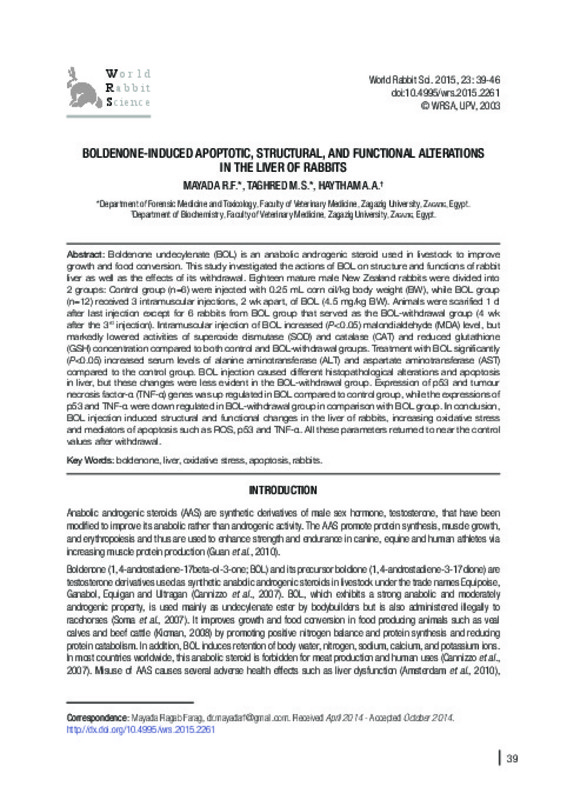JavaScript is disabled for your browser. Some features of this site may not work without it.
Buscar en RiuNet
Listar
Mi cuenta
Estadísticas
Ayuda RiuNet
Admin. UPV
Boldenone-induced apoptotic, structural, and functional alterations in the liver of rabbits
Mostrar el registro sencillo del ítem
Ficheros en el ítem
| dc.contributor.author | Mayada, R.F.
|
es_ES |
| dc.contributor.author | Taghred, M.S.
|
es_ES |
| dc.contributor.author | Haytham, A.A.
|
es_ES |
| dc.date.accessioned | 2015-05-14T08:08:45Z | |
| dc.date.available | 2015-05-14T08:08:45Z | |
| dc.date.issued | 2015-03-26 | |
| dc.identifier.issn | 1257-5011 | |
| dc.identifier.uri | http://hdl.handle.net/10251/50231 | |
| dc.description.abstract | [EN] Boldenone undecylenate (BOL) is an anabolic androgenic steroid used in livestock to improve growth and food conversion. This study investigated the actions of BOL on structure and functions of rabbit liver as well as the effects of its withdrawal. Eighteen mature male New Zealand rabbits were divided into 2 groups: Control group (n=6) were injected with 0.25 mL corn oil/kg body weight (BW), while BOL group (n=12) received 3 intramuscular injections, 2 wk apart, of BOL (4.5 mg/kg BW). Animals were scarified 1 d after last injection except for 6 rabbits from BOL group that served as the BOL-withdrawal group (4 wk after the 3rd injection). Intramuscular injection of BOL increased (P<0.05) malondialdehyde (MDA) level, but markedly lowered activities of superoxide dismutase (SOD) and catalase (CAT) and reduced glutathione (GSH) concentration compared to both control and BOL-withdrawal groups. Treatment with BOL significantly (P<0.05) increased serum levels of alanine aminotransferase (ALT) and aspartate aminotransferase (AST) compared to the control group. BOL injection caused different histopathological alterations and apoptosis in liver, but these changes were less evident in the BOL-withdrawal group. Expression of p53 and tumour necrosis factor-α (TNF-α) genes was up regulated in BOL compared to control group, while the expressions of p53 and TNF-α were down regulated in BOL-withdrawal group in comparison with BOL group. In conclusion, BOL injection induced structural and functional changes in the liver of rabbits, increasing oxidative stress and mediators of apoptosis such as ROS, p53 and TNF-α. All these parameters returned to near the control values after withdrawal. | es_ES |
| dc.language | Inglés | es_ES |
| dc.publisher | Editorial Universitat Politècnica de València | |
| dc.relation.ispartof | World Rabbit Science | |
| dc.rights | Reserva de todos los derechos | es_ES |
| dc.subject | Boldenone | es_ES |
| dc.subject | Liver | es_ES |
| dc.subject | Oxidative stress | es_ES |
| dc.subject | Apoptosis | es_ES |
| dc.subject | Rabbits | es_ES |
| dc.title | Boldenone-induced apoptotic, structural, and functional alterations in the liver of rabbits | es_ES |
| dc.type | Artículo | es_ES |
| dc.date.updated | 2015-05-14T07:38:36Z | |
| dc.identifier.doi | 10.4995/wrs.2015.2261 | |
| dc.rights.accessRights | Abierto | es_ES |
| dc.description.bibliographicCitation | Mayada, R.; Taghred, M.; Haytham, A. (2015). Boldenone-induced apoptotic, structural, and functional alterations in the liver of rabbits. World Rabbit Science. 23(1):39-46. https://doi.org/10.4995/wrs.2015.2261 | es_ES |
| dc.description.accrualMethod | SWORD | es_ES |
| dc.relation.publisherversion | https://doi.org/10.4995/wrs.2015.2261 | es_ES |
| dc.description.upvformatpinicio | 39 | es_ES |
| dc.description.upvformatpfin | 46 | es_ES |
| dc.type.version | info:eu-repo/semantics/publishedVersion | es_ES |
| dc.description.volume | 23 | |
| dc.description.issue | 1 | |
| dc.identifier.eissn | 1989-8886 | |
| dc.description.references | Ashkenazi, A. (1998). Death Receptors: Signaling and Modulation. Science, 281(5381), 1305-1308. doi:10.1126/science.281.5381.1305 | es_ES |
| dc.description.references | Battista V., Combs J., Warne W.J. 2003. Asynchronous bilateral Achilles tendon ruptures and rostenedioluse. Am. J. Sports Med., 31: 1007–1009. | es_ES |
| dc.description.references | Cannizzo T.F., Zancanaro G., Spada F., Mulasso C., Biolatti B. 2007. Pathology of the Testicle and Sex Accessory Glands Following the Administration of Boldenone and Boldione as Growth Promoters in Veal Calves. J. Vet. Med. Sci., 69: 1109-Du Toit E.F., Rossouw E., Van Rooyen J., Lochner A. 2005. Proposed mechanisms for the anabolic steroid-induced increase in myocardial susceptibility to ischemia/reperfusion injury. Cardiovasc. J. Afr., 16: 21-28. | es_ES |
| dc.description.references | Navarro, M., Montilla, M., Martín, A., Jiménez, J., & Utrilla, M. (1993). Free Radical Scavenger and Antihepatotoxic Activity ofRosmarinus tomentosus. Planta Medica, 59(04), 312-314. doi:10.1055/s-2006-959688 | es_ES |
| dc.description.references | Rokhlin, O. W., Gudkov, A. V., Kwek, S., Glover, R. A., Gewies, A. S., & Cohen, M. B. (2000). p53 is involved in tumor necrosis factor-α-induced apoptosis in the human prostatic carcinoma cell line LNCaP. Oncogene, 19(15), 1959-1968. doi:10.1038/sj.onc.1203453 | es_ES |
| dc.description.references | Urhausen, A., Torsten, A., & Wilfried, K. (2003). Reversibility of the effects on blood cells, lipids, liver function and hormones in former anabolic–androgenic steroid abusers. The Journal of Steroid Biochemistry and Molecular Biology, 84(2-3), 369-375. doi:10.1016/s0960-0760(03)00105-5 | es_ES |
| dc.description.references | Wang L., Bowman L., Lu Y., Rojanasakul Y., Mercer R.R., Castranova V., Ding M. 2005. Essential role of p53 in silicainduced apoptosis. Am. J. Physiol., 288: 488-496. | es_ES |
| dc.description.references | Wong G., Vehar G., Kaspar R.L. 1997. Apoptosis and Cancer. Martin SJ (ed.) KargerLandes System, pp. 245-257. | es_ES |
| dc.description.references | Zaugg, M., Jamali, N. Z., Lucchinetti, E., Xu, W., Alam, M., Shafiq, S. A., & Siddiqui, M. A. Q. (2001). Anabolic-androgenic steroids induce apoptotic cell death in adult rat ventricular myocytes. Journal of Cellular Physiology, 187(1), 90-95. doi:10.1002/1097-4652(2001)9999:9999<00::aid-jcp1057>3.0.co;2-y | es_ES |








